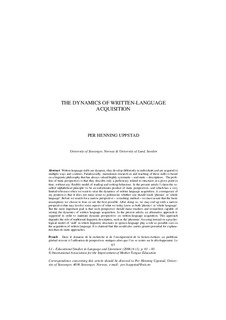| dc.contributor.author | Uppstad, Per Henning | |
| dc.date.accessioned | 2013-03-22T13:38:15Z | |
| dc.date.available | 2013-03-22T13:38:15Z | |
| dc.date.issued | 2006 | |
| dc.identifier.citation | Uppstad, P. H. (2006): The Dynamics of written-language acquisition. L1 – Educational Studies in Language and Literature 6(2006)1, pp. 63-83. | no_NO |
| dc.identifier.issn | 1567-6617 | |
| dc.identifier.uri | http://hdl.handle.net/11250/185912 | |
| dc.description | URL: http://l1.publication-archive.com/public?fn=enter&repository=1&article=4 | |
| dc.description.abstract | Written language skills are dynamic, they develop differently in individuals and are acquired in
multiple ways and contexts. Paradoxically, mainstream research on and teaching of these skills is based on a linguistic philosophy that has always valued highly systematic – and static – descriptions. The problem of static perspectives is that they describe only a proficiency related to structures at a given point in time, without any flexible model of reading and writing behaviour. In the present article I claim the socalled
'alphabetical principle' to be an unfortunate product of static perspectives, and which has a very
limited relevance when we want to seize the dynamics of written language acquisition. A consequence of my position is that it does not make sense to polemicize whether one should teach 'phonics' or 'whole language'. Before we search for a narrow perspective – a teaching method – we must assure that the basic
assumptions we choose to lean on are the best possible. After doing so, we may end up with a narrow perspective that may involve some aspects of what we today know as both 'phonics' or 'whole language'. But the most important goal is that such perspective should make teachers and researchers capable of seizing the dynamics of written language acquisition. In the present article, an alternative approach is
suggested in order to maintain dynamic perspectives on written-language acquisition. This approach degrades the role of traditional linguistic description, such as the 'phoneme', focusing instead on a psychological model of ‘skill’ in which linguistic structures in spoken language play a role as possible cues in the acquisition of written language. It is claimed that this model also carries greater potential for explanation than do static approaches. | no_NO |
| dc.language.iso | eng | no_NO |
| dc.publisher | IAIMTE | no_NO |
| dc.subject | fonologi | no_NO |
| dc.subject | leseforståelse | no_NO |
| dc.title | The Dynamics of written-language acquisition | no_NO |
| dc.type | Journal article | no_NO |
| dc.type | Peer reviewed | no_NO |
| dc.subject.nsi | VDP::Humanities: 000::Linguistics: 010::General linguistics and phonetics: 011 | no_NO |
| dc.source.pagenumber | 63-83 | no_NO |
| dc.source.volume | 6 | no_NO |
| dc.source.journal | L1-Educational Studies in Language and Literature | no_NO |
| dc.source.issue | 1 | no_NO |
